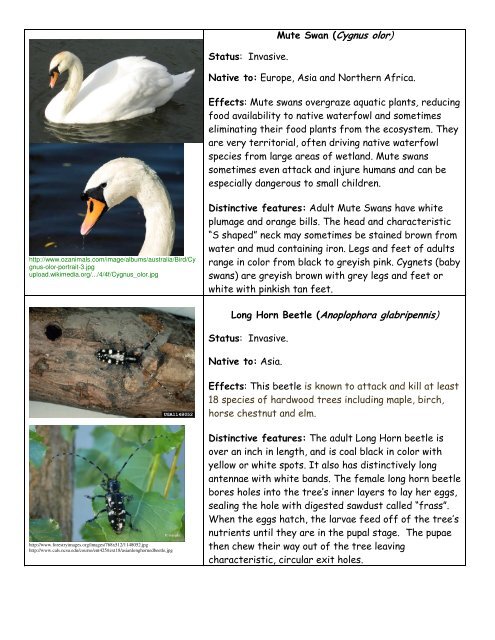Invasive Plants Flashcards (pdf)
Invasive Plants Flashcards (pdf)
Invasive Plants Flashcards (pdf)
You also want an ePaper? Increase the reach of your titles
YUMPU automatically turns print PDFs into web optimized ePapers that Google loves.
http://www.ozanimals.com/image/albums/australia/Bird/Cy<br />
gnus-olor-portrait-3.jpg<br />
upload.wikimedia.org/.../4/4f/Cygnus_olor.jpg<br />
http://www.forestryimages.org/images/768x512/1148052.jpg<br />
http://www.cals.ncsu.edu/course/ent425/text18/asianlonghornedbeetle.jpg<br />
Status: <strong>Invasive</strong>.<br />
Mute Swan (Cygnus olor)<br />
Native to: Europe, Asia and Northern Africa.<br />
Effects: Mute swans overgraze aquatic plants, reducing<br />
food availability to native waterfowl and sometimes<br />
eliminating their food plants from the ecosystem. They<br />
are very territorial, often driving native waterfowl<br />
species from large areas of wetland. Mute swans<br />
sometimes even attack and injure humans and can be<br />
especially dangerous to small children.<br />
Distinctive features: Adult Mute Swans have white<br />
plumage and orange bills. The head and characteristic<br />
“S shaped” neck may sometimes be stained brown from<br />
water and mud containing iron. Legs and feet of adults<br />
range in color from black to greyish pink. Cygnets (baby<br />
swans) are greyish brown with grey legs and feet or<br />
white with pinkish tan feet.<br />
Long Horn Beetle (Anoplophora glabripennis)<br />
Status: <strong>Invasive</strong>.<br />
Native to: Asia.<br />
Effects: This beetle is known to attack and kill at least<br />
18 species of hardwood trees including maple, birch,<br />
horse chestnut and elm.<br />
Distinctive features: The adult Long Horn beetle is<br />
over an inch in length, and is coal black in color with<br />
yellow or white spots. It also has distinctively long<br />
antennae with white bands. The female long horn beetle<br />
bores holes into the tree’s inner layers to lay her eggs,<br />
sealing the hole with digested sawdust called “frass”.<br />
When the eggs hatch, the larvae feed off of the tree’s<br />
nutrients until they are in the pupal stage. The pupae<br />
then chew their way out of the tree leaving<br />
characteristic, circular exit holes.


